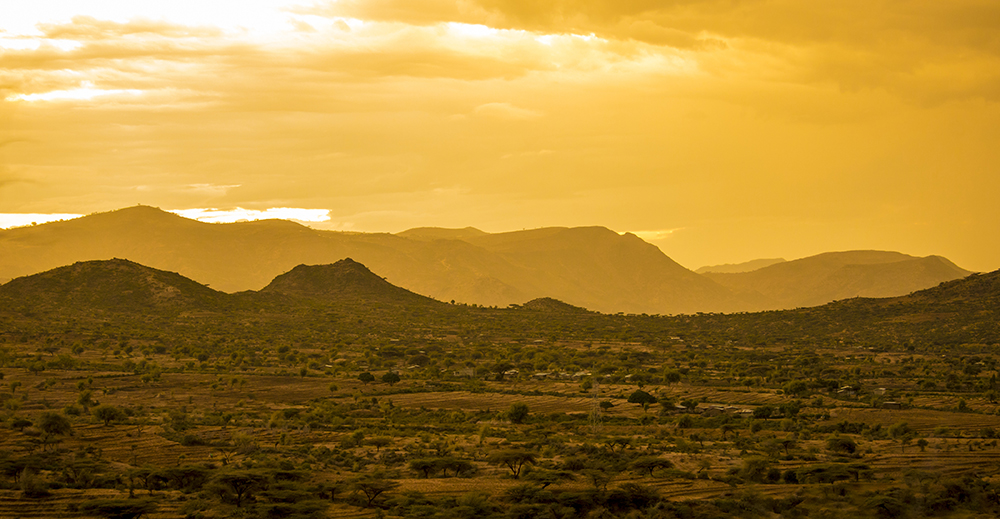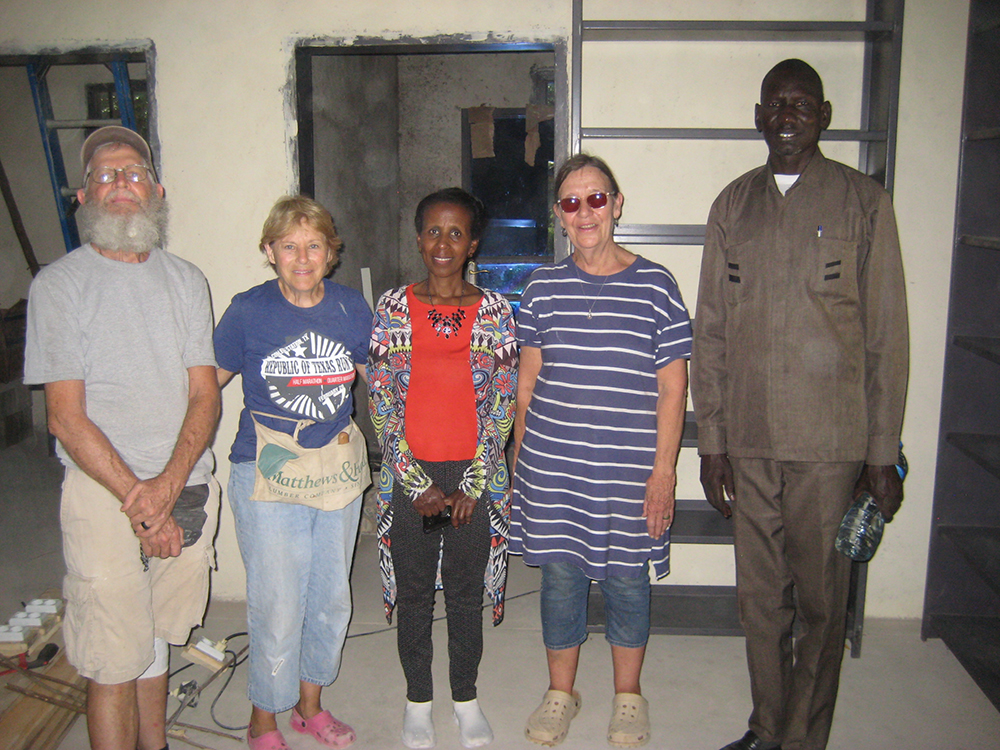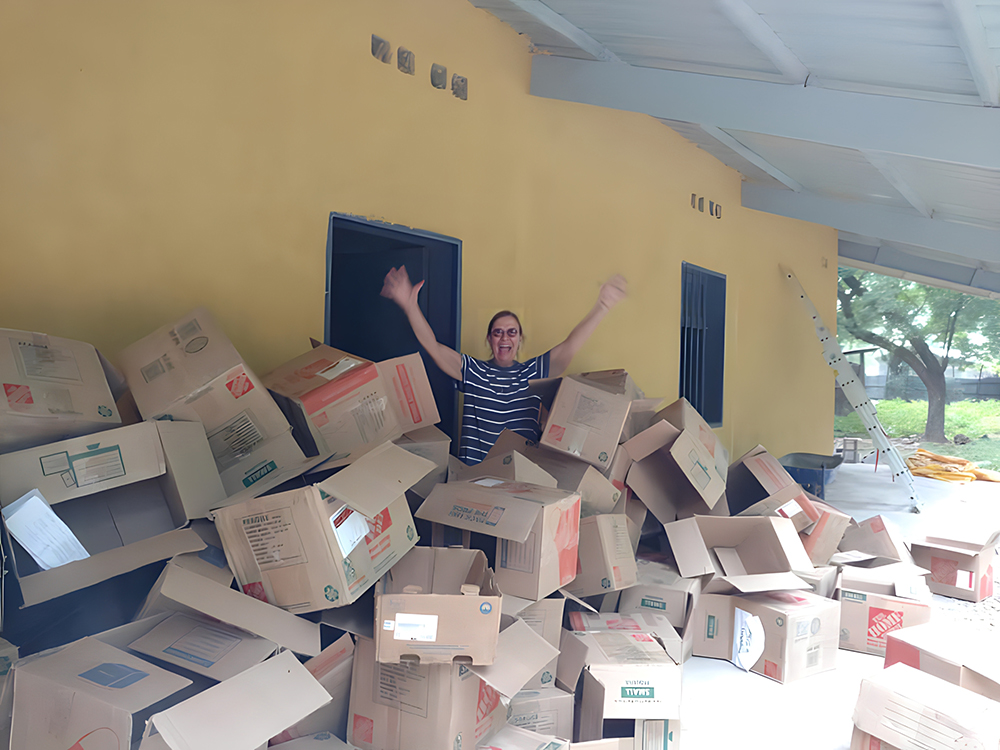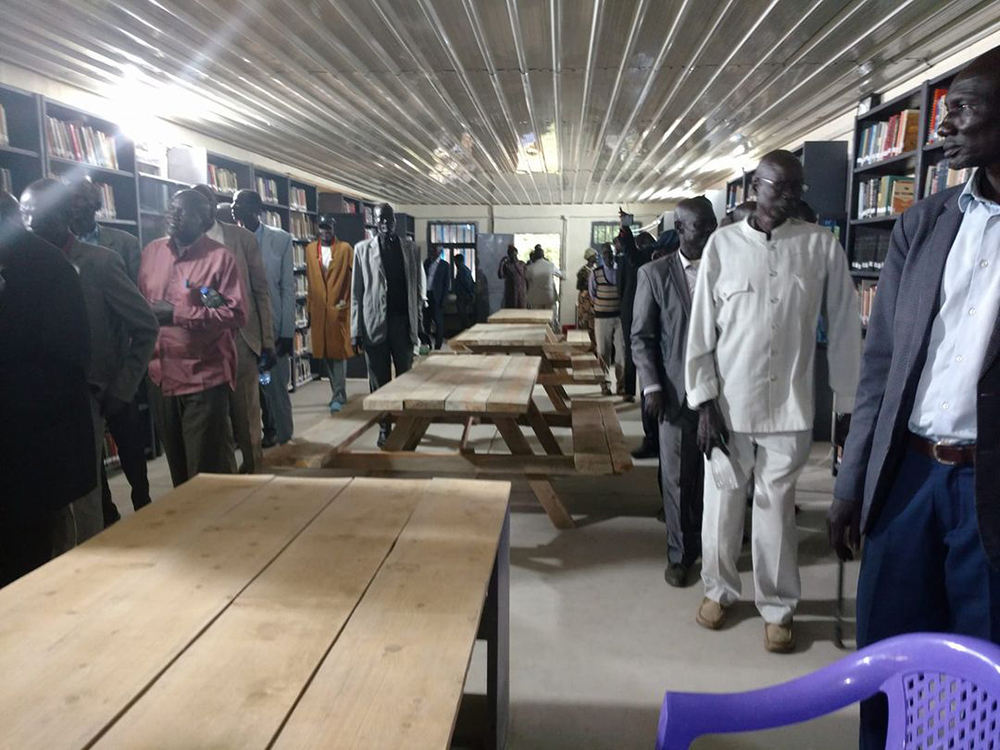An alumna returns to the country she had visited a half-century earlier and helps complete a library in honor of her brother-in-law.
by Carolyn K. Pollock ’70
When most travelers think of going to Africa, they conjure up images of game parks, rainforests, brightly patterned fabrics, drums, dancing, and tribal customs. My trip from September to early October 2022 to Gambela, Ethiopia, was not to admire the local culture and take photos of the wildlife. It was for the specific and practical purpose of completing a library for a local college. Even so, still in the back of my mind were the lush rainforest memories from my first trip to Ethiopia 50 years earlier.
That trip was to visit my in-laws, Ted and Dolly Pollock, who were construction missionaries in Mizan Teferi, a mountainous area populated by the Gulla tribe, about 100 miles southeast of Gambela. My husband Bill and I took summer leave from a teaching stint in Alexandria, Egypt, to assist his parents in the mission compound workshop. We fabricated metal triangles that would bolt together to make geodesic domes. As triangles, they could fit easily into a Mission Aviation Fellowship Cesena plane to be transported to sites where they would be assembled, like an Erector Set, for missionary housing, clinics, schools, etc.
The Pollocks began their missionary careers in 1946 under the Mission Board of the United Presbyterian Church of North America, going to what is now South Sudan as construction missionaries. Their work there ended in 1962 with the expulsion of all mission workers. Subsequently, Ethiopia opened up to a mission presence, so they began doing the same work in the southwest of that country in 1963.
My husband and his six siblings have continued their parents’ legacy by investing in South Sudan and Ethiopia and their many people groups. Although all seven siblings have been involved in various short-term building projects around the globe, only one younger sister, Leah, and her husband, Dave Preston, became career missionaries. They began with Jungle Aviation and Radio Support (JAARS), an offshoot of Wycliffe Bible Translators.
Six years ago, Bill’s older brother Ed had a visit from Ding Gatch to his home in Maryland. Gatch was head of the West Gambela Mekane Yesus (Light of Jesus) Synod in Gambela, Ethiopia, and was looking for funding to build a library for a Bible school serving students of all ages, mostly from the Nuer tribe, which populates South Sudan as well as Western Ethiopia. (Many are displaced refugees due to ongoing conflicts in Sudan and South Sudan.) One requirement for the school to be able to offer a degree program, as opposed to just a diploma program, was the construction of a library capable of housing 6,000 volumes. Ed put out the word, and members of our large family began collecting books from pastor friends, Bible schools, etc.
Sadly, Ed was diagnosed with pancreatic cancer and realized he would not be able to fulfill this mission. He commissioned Leah, who does mission projects all around the world, to carry out the vision. Planning a project of this magnitude long distance is a challenge. Gambela, (also spelled Gambella), southwestern Ethiopia, is a rather depressed area economically. Just about everything had to be ordered from the capital city, Addis Ababa, which is a couple of days’ trip over unmaintained roads. Luckily, Leah is a super optimistic, faith-filled, energetic woman. Once she sets her mind to do something, it WILL be done because she is not a quitter. After Ed’s death three years ago, Leah began in earnest to plan the building with the help of other family members.
John McFarland, her brother-in-law and a civil engineer, designed the building and worked with Ethiopian Steel to have materials made to his specs. The building was designed to be nine by 23 meters, with a lovely metal roof overhang to provide an outside shaded area for studying. The trusses and other steel parts were ordered and fabricated in 2020. Then Covid put the project on hold. The metal parts were put in storage in Addis Ababa, and the books sat in a container on a dock in Baltimore because of the travel bans.
Finally, in August 2021, the situation opened up, and three family members, plus the son of the missionary after whom the Bible school is named, went with Leah and her new husband, Don Vander Ploeg (Dave Preston passed away seven years ago), to begin the construction. The project was fraught with difficulties. While in storage, pieces of the building began “disappearing,” either sold for other projects or stolen. Only about half of the building parts arrived on site (and the custom-built shelves arrived BEFORE the building pieces). The bolt holes had been drilled in the wrong places in the trusses, a gas-powered welder to be used during the daily electrical outages was broken, and there were water pump issues, etc. The time frame doubled, but eventually, the walls and roof were erected, and doors and windows were attached. The 140 cartons of books arrived and were stored in a guest house.
Last year, Leah and Don asked for help completing the building — cement stucco on the outside, painting, installation of electricity and solar panels, construction of picnic tables, and then cataloging and shelving the books! I thought, “I LOVE BOOKS! Perfect! I’ll go….”
It wasn’t as simple as it sounds. The Ethiopia I remembered, with its variety of tropical fruits, wonderfully maintained compound, and cool weather, was not the Ethiopia in which I landed. This area, to the west of the Ethiopian Rift, is basically at sea level with a hot, arid climate. Gambela’s airport has one gate, two flights a day, and three security checks! The ride to the compound was over roads that had had little maintenance in years. There is no garbage collection in Gambela, so waste is routinely just dropped on the ground where it stays.
The streets are lined with small shops, and large ornate gates cordon off residential sections. Women make injera, the large sourdough “pancake,” which is the national dish, over their charcoal burners, and tea glasses clink as the sugar is stirred in. Being populated by mostly Nuers, a very tall Nilotic people group, I was struck by how elegantly dressed the ladies were! It was normal to see gowns we would think of as evening wear or prom dresses worn for a stroll down the street — presenting an elegance in shocking contrast to the trash-filled gutters. Another thing that struck me as particularly strange was that the store manikins displaying elegant clothing were mostly white-skinned!
Three-wheeled motorized Bajajs were the most common means of transportation in addition to a few bicycles. Music blared, and children played, some half-naked, on the roads. One child about two years old took a glance at me, screamed, then cried and ran away. (I saw no other white people while there.)
Because construction was ongoing and the dust from it everywhere, before Leah and I could even get to the books, we spent time cleaning the building. It was like trying to shovel in the midst of a snowstorm! We were totally blessed to have Sara Demissie, the head librarian from the Ethiopian Graduate School of Theology, come from Addis Ababa to assist us. The books had been packed with spreadsheets listing their contents, but now labels had to be applied. (We did most of this without a computer because the new computer Leah brought did not support the current library system used in Ethiopia, so it was abandoned.)
At night, I worked on the books. During the day, I would help by having the hired young men clean cement and paint off the windows, doors, floors, EVERYTHING! The unemployment rate is extremely high, so we had no trouble getting workers, although most were unskilled and had to learn on the job! Everything was a learning curve for all of us and not easy. But hearing the young men burst out into song in the midst of mixing mortar, fabricating electrical installation, and painting was memorable and soul-lifting. Often it was a call-and-response type of song.
For lunch, we had a young lady cook for all the workers… mostly a potato and spicy sauce dish served with injera, the national staple. To eat, one tears off a piece, then uses it to pick up the potato and sauce between the thumb and fingers. (I shamelessly opted for a spoon!) The young men would change out of their work clothes, gather at the community pump for fresh water, wash and put on clean clothes for lunch, served in a stick enclosure wrapped in a blue tarp. After lunch, they would change back into their work clothes for the afternoon work.
Between the house where we stayed and the library was a multipurpose tree-shaded area used for choir practice, complete with drumming, large Bible study groups on ubiquitous plastic chairs, small classes, and more. This was the site for slaughtering the goat for our dedication celebration (although sadly, it was NOT the goat who daily pooped on the concrete area around the building!). It also served as an impromptu kitchen set up for making the tea and washing the dishes since it was near the pump. One night I was not attentive enough to hear the splish splash and almost walked into a night bather! When we worked into the evening, we could hear the youth playing basketball on the newly built court and distant singing. The heavy rains on the metal roof of the house where we stayed drowned out the other noises, but sadly the gutter system was not set up for rain collection, which would have greatly alleviated the water shortage.
Electricity was intermittent, and water was scarce. I learned to take a shower with about two quarts of water. Food choices were extremely limited, which was such a disappointment after the rainforest fruits of 50 years earlier, not even bananas. And the best coffee, for which Ethiopia is known, was exported! But working with Sara, the librarian, was the highlight of my trip. We connected over our shared hardships — sweating when the fans went off, swatting mosquitoes by the dozens, trying to focus by headlamps on the tiny Dewey Decimal System numbers to add to the labels, etc. But the banner day arrived when we finished cataloging the last book — at 4:15 am! (Then, to catch a few hours of sleep with the barking dogs, roosters, donkey brays, and crying children!)
That morning the Bible school students carried the books down to the library, even though some construction was still happening! We unpacked and sorted into shelves with temporary numbered notes, trying to estimate how many books were in each section! Next, we pulled each numbered section off the shelves onto long tables and did the final sort. We made labels for the shelves, color-coded reference books, and I learned about more translations of the Bible than I’d ever known existed before!
Long term, we hope the library gets good use. Sara said it is probably among the top 10 libraries in all of Ethiopia. It is difficult for these students — speaking Nuer as their first language, Amharic as their second, and English as their third! The looks of awe on the faces of each person who came in, you would think they were entering a mint! They would touch the books reverently and say, “fantastic, wonderful, thank you, good work… .” Emblazoned in my mind is a picture of Leah showing the workers her Dad’s autobiography (“Christ’s Globe-Trotter,” published in 2005) and telling them about the projects he worked on over the years. Don gave each of the workers a pocket Bible, and seeing them sitting at the tables reading, was gratifying. There is a young man, Moses Hoth Lual, working on an updated translation of the Nuer Bible. He will most likely be able to do research at the library. The Bible school is named after the missionary who first translated the Bible into Nuer – Manpiny Theological College. And the E. O. Pollock Memorial Library has been named after my brother-in-law.
While washing the windows in time for the mid-afternoon dedication ceremony on Sunday, I listened to the chopping of the cleavers preparing the goat stew and watched the Bajajs arriving with women unloading bags of bread, cases of water, dishes, silverware, and teapots. Plastic chairs were set up under the roof overhang for all the dignitaries and Bible school students. (About twice the number that was originally estimated showed up — a few extras must have smelled the goat cooking!) Speeches were translated from Nuer to Amharic to English, as dignitaries from both East and West Gambela Synod, the Bible School President, and more talked from their hearts. I chuckled, watching the President of the West Gambela Synod take multiple selfies.
One older gentleman, dressed in a mustard-colored full-length wool coat, completed his outfit with a fly swisher that looked similar to a cheerleader’s pompom. When the doors were opened for the grand tour, he filed in with great pomp and began giving the joy cry, which caught on with others filing behind him. Amidst the “oohs and aahs,” my weariness lifted, and I could catch a glimpse of hope for people who have so little. As each one washed their hands in a basin with Leah pouring the water in preparation for their goat feast, I anticipated my return home, vowing to take less for granted, to count my many blessings, and to think twice before complaining over little annoyances. May my heart sing in gratitude for the lovely people who helped bring my brother-in-law’s vision to completion.







